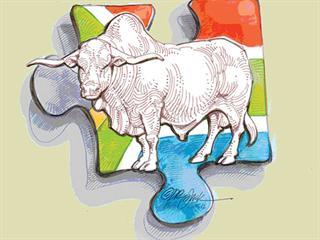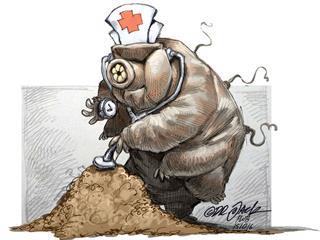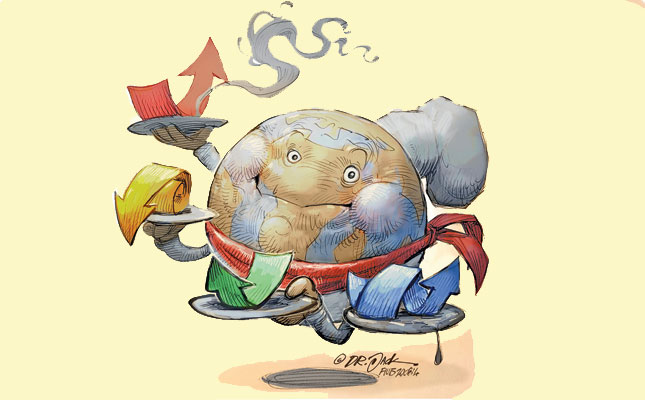
Developed countries can produce cheap food in large-scale production systems. However, the reality is that 70% of global food is produced in Africa, Asia and Latin America by several billion small-scale, subsistence, communal farming families, livestock keepers and pastoralists.
Cattle are the principal livestock species in Africa and Latin America, and the beef production systems in which they are run depend primarily on the environment and the level of management. The environment needs to be matched to the correct genotype for increased and sustainable production.
Brazil, Uruguay and Argentina are substantial net exporters of beef, cornering more than 35% of world trade in 2005. In contrast, southern African countries, with the exception of Botswana and Namibia, are all net importers of beef. This is despite the potential of these regions to support thriving beef industries.
Production
The cattle sectors in South America and sub-Saharan Africa consist of two distinct groups: communal/subsistence or small-scale farmers, and large commercial farmers. These two groups must, of necessity, coexist.
While the commercial sector sells or markets a high percentage of beef annually, offtake from the other sectors is still low in many parts of the sub-Saharan region. This is mainly due to low fertility and high mortality. If these problems can be resolved, resulting in improved production, the region’s beef industry will have limitless opportunities for growth.
In the South African commercial beef sector, 52% of animals are mateable females, with this figure dropping to 49% in the emerging sector and 25% in the communal sector. The calving percentage in the commercial sector is 62%, while it is 48% in the emerging sector and 35% in the communal sector.
Preweaning mortalities run at 3,1% in the commercial sector, 3,3% in the emerging sector and 30,7% in the communal sector. Offtakes are 32% for commercial beef farmers, 25% for emerging beef farmers and 6% for communal/subsistence farmers.
Beef production in communally-farmed systems faces numerous difficulties. To begin with, farmers’ land and other resources are shared, so there are many grazing decision-makers. However, because the stock is privately owned, the owner makes individual resolutions about the management of his/her stock.
In the communal model, individuals are encouraged to own more cattle, so that the chances of retaining animals after a natural disaster, such as drought, are increased. When these events occur, there are major losses in communal herds because the grazing, can no longer support the animal numbers.
In the Brazilian Pantanal, the world’s largest freshwater wetland, calving percentages were low and preweaning mortalities high. After a four-year period of monitoring and intervention by the authorities to introduce adapted genotypes, preweaning mortalities dropped by about 50% and the calving percentage increased by 25%.
In the USA, the offtake rate is 37%, in Argentina and Uruguay it is 30%, and in SA commercial herds it is 32%. However, South Africa’s communal herd with its 6% offtake, which makes up 40% of the national beef herd, brings South Africa down to an average offtake of 22%, and puts the country on a par with Brazil.
The challenge and possible solution for many of the communal system’s problems is to introduce and improve the use of technology and modern livestock management systems.
Demand and development
The increased demand for meat has created markets and favourable circumstances for beef farmers. This is the result of an increasing population, as well as urban and economic development, especially in developing countries.
According to an FAO report in which authors refer to “The Livestock Revolution”, world demand for meat is expected to double from 229 million tons in 1999 to 465 million tons in 2050. To meet the demand, there needs to be a significant increase in beef production in developing countries.
Farmers operating at subsistence, smallholder or emerging levels will have to improve productivity to commercial levels. This will help address poverty in agriculturally-based economies while producing the meat demanded by consumers.
The right genotypes
It is anticipated that the dam lines of indigenous and adapted breeds will be used more extensively to enhance the Third World beef sector’s competitiveness. These breeds have a smaller frame, lower feed requirements, good maternal qualities, light birth weights, and low levels of neonatal mortality. Using the right genotypes can increase production efficiency. This is measured in kg/ calf weaned/large stock unit, through sustainable crossbreeding systems. Increasing production would mean ‘more’ weaner calf from the same amount of feed.
Climate change
All scenarios indicate an increase in temperatures and a drier southern African area. Increases in average temperatures of between 1,5°C and 2°C are predicted, ranging (east to west) from 0,5°C at seaboard to 3°C in eastern Namibia and western Botswana.
There will generally also be less rain, except for the central areas of South Africa and the Eastern Cape. A significant reduction of more than 40mm of rainfall/year is predicted for the eastern parts of Limpopo and Mpumalanga, the south-western Cape and the Cape south coast.
Geo-referenced information systems (GIS) and satellite images provide information on temperature, relative humidity, precipitation (including variation in rainfall), day length and radiation. GIS also indicates vegetation indices, dry matter productivity, and levels of toxins, minerals, salts and tannins. It is therefore important for cattle owners to record GPS waypoints and animal performance.
Recording and improvement
If the production environment can be described, suitable breeds or genotypes adapted to specific environments can be identified. Variation in genetic potential can be fully expressed in an environment to which a breed is adapted. Thus, animal performance should be linked to the production environment.
Animal recording forms the backbone of any improvement programme; if traits are not measured, no improvement is possible. Equally, however, using the best recording and improvement schemes and genomic information will not have the expected outcomes if farmers do not know how to interpret the information.
There are major differences between breeding cattle for the tropical or subtropical zones, and breeding them for the temperate zones. Parasites, seasonally poor nutrition, high temperature variation, high and low humidity, and temperament, exacerbated by extensive production systems, are all problems that can occur in tropical areas.
These difficulties can be solved by breeding cattle that are productive without the need for artificial intervention.
Genomics in dairy cattle is already reasonably advanced but there are challenges for beef cattle breeding in the science of genomics. Most countries in the region have a variety of breeds, but many of these do not have the resources to genotype sufficient numbers so that genomic EBVs can be rendered.
The greatest challenge facing the beef industry is the limited recording of performance traits. In the harsh, undeveloped areas of pastoralist systems, pure breeding with Sanga (African) and Zebu of naturalised breeds may well be the only feasible production strategy. And even in the more developed areas, cross-breeding with smaller, adapted cows will improve the output of beef cattle farming. – Nan Smith
Email Prof Michiel Scholtz at [email protected].
The views expressed in our weekly opinion piece do not necessarily reflect those of Farmer’s Weekly.













